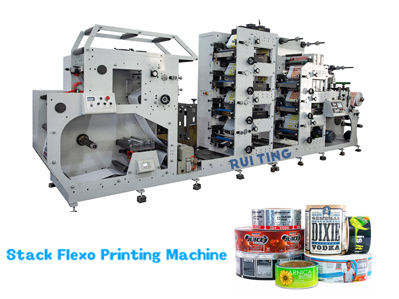Blog

A stack flexo printing machine is a type of flexible packaging and label printing equipment characterized by vertically stacked printing units, each positioned independently on a central frame or "stack." This design allows each color station (typically 4–10 units) to be mounted on either side of a main frame or along a vertical column, enabling versatile configuration for multi-color printing on flexible substrates like paper, plastic films, foil, or corrugated board.
The machine consists of core components:
• Printing Units: Each unit holds a flexible relief printing plate (flexographic plate) mounted on a plate cylinder, paired with an anilox roller for precise ink metering.
• Unwinding & Rewinding Systems: Feed the substrate through the machine and collect the printed material.
• Drying Systems: Infrared or air-drying tunnels cure solvent-based or water-based inks between color layers.
Operation follows a stepwise process: the substrate passes through each printing unit sequentially, with each unit adding a different color. The stack configuration allows easy access to individual units for quick plate changes, making it ideal for short-to-medium print runs.
Stack flexo machines excel in packaging production (e.g., food wrappers, beverage labels, shopping bags) and corrugated box printing. Their key benefits include:
• Flexibility: Adaptable to various substrate thicknesses and widths, with quick setup for job changes.
• Cost Efficiency: Lower initial investment compared to satellite-style flexo presses, suitable for small businesses or frequent design updates.
• Space Savings: Vertical stacking minimizes floor space usage, though alignment precision relies on operator expertise.
When selecting a machine, prioritize:
• Substrate Compatibility: Ensure the press handles your target materials (e.g., PVC, polyethylene, or paperboard).
• Color Capacity: Match the number of printing units to your typical color requirements (e.g., 6 units for full-color CMYK + spot colors).
• Drying Technology: Solvent-based inks need robust drying systems, while water-based inks may require gentler air-flow setups.
• Automation Level: Semi-automated models reduce manual adjustments, but fully automated presses improve consistency for high-volume runs.
Regular upkeep ensures optimal print quality and longevity:
• Clean Anilox Rollers: Use specialized brushes or ultrasonic cleaners to remove dried ink buildup, which causes streaking or uneven ink transfer.
• Inspect Print Plates: Replace worn or damaged flexo plates to avoid blurry edges or missed details.
• Lubricate Moving Parts: Grease gear trains, bearings, and guides to prevent friction-related downtime.
• Calibrate Tension Systems: Uneven substrate tension leads to registration errors—verify sensor accuracy monthly.
Stack flexo printing machines offer a balance of versatility and affordability for packaging and label production. Proper selection based on production needs, combined with proactive maintenance, ensures consistent output and cost-effective operation in dynamic printing environments.
Latest News
Exhibition 2023 labelexpo Asia
The 2023 labelexpo Asia show we participated in in December was a complete success. I am v...
Jun 14,2024
Oct 14,2025
What Factors Play a Role in Choosing the Optimal Production Speed for Packaging Printing Equipment?
When purchasing packaging printing equipment, production speed stands out as a critical fa...
Oct 13,2025
GET A QUOTE